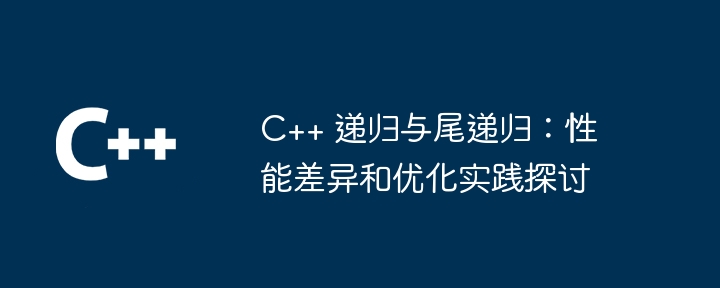
Standard recursion in C will incur stack space and time overhead, but tail recursion will not. Optimization practices include identifying tail recursions, converting to tail recursions, and enabling compiler support. Tail recursion is more performant than standard recursion because it avoids the creation of additional activity records and the associated overhead.

C Recursion and Tail Recursion: Discussion on Performance Differences and Optimization Practices
Recursion is a powerful programming technique that allows The function calls itself. In C, however, the standard recursive implementation incurs significant performance overhead. Tail recursion is a form of optimization that eliminates this overhead.
Performance Difference
Standard recursion works by creating new activity records (ARs) on the stack, each AR containing the information necessary for the function call, such as local Variables, return addresses, and caller context. When calling tail recursion, a new AR is not created because the tail call uses the caller's AR directly.
This mechanism leads to two key performance differences:
Optimization Practice
In order to optimize recursive programs, you can adopt the following practices:
Practical Case
Consider the following standard recursive function that computes the factorial:
int factorial(int n) { if (n == 0) { return 1; } return n * factorial(n - 1); }
By moving the recursive call to the beginning of the function, you can Convert this to tail recursion:
int factorial_tr(int n, int result = 1) { if (n == 0) { return result; } return factorial_tr(n - 1, result * n); }
The tail recursive version is significantly better in performance than the standard version because it avoids the creation of additional ARs and related overhead.
Conclusion
Understanding the performance difference between recursion and tail recursion is crucial to optimizing C programs. By identifying tail recursion and using appropriate techniques, you can significantly improve the efficiency of your program.
The above is the detailed content of C++ Recursion and Tail Recursion: Discussion on Performance Differences and Optimization Practices. For more information, please follow other related articles on the PHP Chinese website!
 What are the differences between c++ and c language
What are the differences between c++ and c language Recommended learning order for c++ and python
Recommended learning order for c++ and python Cost-effectiveness analysis of learning python and c++
Cost-effectiveness analysis of learning python and c++ Is c language the same as c++?
Is c language the same as c++? Which is better to learn first, c language or c++?
Which is better to learn first, c language or c++? The difference and connection between c language and c++
The difference and connection between c language and c++ C++ software Chinese change tutorial
C++ software Chinese change tutorial Cost-effectiveness analysis of learning python, java and c++
Cost-effectiveness analysis of learning python, java and c++



